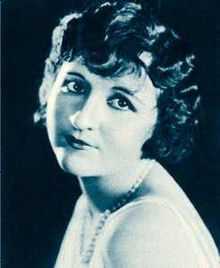Julia Faye
| Julia Faye | |
|---|---|
 | |
| Born |
September 24, 1892 Richmond, Virginia, U.S. |
| Died |
April 6, 1966 (aged 73) Hollywood, Los Angeles, California, U.S. |
Cause of death | cancer |
Resting place | Hollywood Forever Cemetery |
| Occupation | actress |
| Years active | 1915-1963 |
| Partner(s) | Cecil B. DeMille |
Julia Faye (September 24, 1892 – April 6, 1966) was an American motion picture actress.[1]
Career overview
Faye had lived in St. Louis, Missouri prior to coming to Hollywood in 1916, to visit friends. She visited one of the film studios and was introduced to Christy Cabanne. The two reminisced about St. Louis and discovered that they had lived next door to one another there. Cabanne persuaded Faye's reluctant mother to allow her to be in motion pictures.[2]
She appeared in more Cecil B. DeMille movies than any other actress. She appeared in many of his silents and in every one of his movies from 1939's Union Pacific on. She was DeMille's mistress off-screen for quite some time and DeMille kept her employed in bit parts long after her career (and their relationship) was over, including his most famous film, The Ten Commandments (1956).
Movie actress
In 1919 Faye played the stenographer in Stepping Out. Cast with Enid Bennett, Niles Welch, and Gertrude Clair, Faye was complimented by a critic for playing her role with "class".[3] It Pays To Advertise (1919) is a Paramount Pictures release adapted by Elmer Harris from the play of the same name by Rol Cooper Megrue and Walter Hackett. It was directed by Donald Crisp. Faye is among the actors with Lois Wilson depicting the leading lady.[4] Changing Husbands (1924) is a Leatrice Joy comedy adapted from a magazine story entitled Roles. Faye joined Raymond Griffith and Zasu Pitts in the screen feature.[5] Faye was listed as a member of the Paramount Stock Company School in July 1922. Its noteworthy personalities included Rudolph Valentino, Gloria Swanson, Betty Compson, Wallace Reid, Bebe Daniels, and Pola Negri.[6]
When DeMille resigned as director general of Famous Players-Lasky, in January 1925, he became the production head of Cinema Corporation of America. He planned to direct two or three films per year and supervise the making of between ten and twenty more. Faye came along with him as did Joy, Rod La Roque, Florence Vidor, Mary Astor, and Vera Reynolds.[7]
The Volga Boatman (1926) is directed by DeMille and named for the noted Russian song. William Boyd, Elinor Fair, and Faye have primary roles in a production DeMille called his greatest achievement in picture making.[8] Faye's depiction of a tiger woman is esteemed as the most captivating of her career, to this point.[9] Before this role she had been known for "silken siren roles". Theodore Kosloff played opposite her as a stupid blacksmith.[10]
Faye played "Martha" in The King of Kings (1926). Christ, portrayed by H.B. Warner, is introduced with great majesty in the DeMille photodrama. A blind child searches for the Lord and the producer/director turns the camera gradually down to the child's eyes. The viewer sees Christ initially like the blind child whose sight is restored.[11] Faye traveled to New York City for personal appearances in association with The King of Kings and to address a sales convention in Chicago, Illinois.[12]
Selected filmography
- The Woman God Forgot (1917)
- The Whispering Chorus (1918)
- Old Wives for New (1918)
- Till I Come Back to You (1918)
- The Squaw Man (1918)
- Don't Change Your Husband (1919)
- Stepping Out (1919)
- Male and Female (1919)
- The Six Best Cellars (1920)
- Something to Think About (1920)
- Life of the Party (1920)
- Forbidden Fruit (1921)
- Fool's Paradise (1921)
- Saturday Night (1922)
- A Trip to Paramountown (1922)(*short)
- Manslaughter (1922)
- Nice People (1922)
- Adam's Rib (1923)
- The Ten Commandments (1923) - The Pharaoh's Wife
- Triumph (1924)
- Changing Husbands (1924)
- Feet of Clay (1924)
- The Golden Bed (1925)
- The Road to Yesterday (1925)
- The Volga Boatman (1926)
- The Fighting Eagle (1927)
- The Godless Girl (1929)
- The Squaw Man (1931)
- Till We Meet Again (1936)
- Northwest Mounted Police (1940)
- The Ten Commandments (1956) - Elisheba
References
- ↑ The Army of Ushers, New York Times, February 17, 1924, pg. X5.
- ↑ "Beauty's Visit Here Starts Film Career", Los Angeles Times, July 18, 1926, p. C32
- ↑ The Screen, September 22, 1919, New York Times, p. 8
- ↑ Written On The Screen, New York Times, November 9, 1919, p. XX5
- ↑ Around the Movie World, May 11, 1924, p. X5
- ↑ "Pictures Plays And People", New York Times, July 30, 1922, p. 81
- ↑ "DeMille Organizes A New Film Concern", New York Times, February 6, 1925, p. 14
- ↑ "DeMille's 'Volga Boatman'", New York Times, April 12, 1926, p. X5
- ↑ "[Faye] Plays Vivid Role In De Mille Opus", Los Angeles Times, May 12, 1926, p. A9
- ↑ "Julia Faye Has Comedy Role in Volga Boatman", Los Angeles Times, May 14, 1926, p. A8
- ↑ "Christ's Life Filmed", New York Times, November 21, 1926, pg. X7.
- ↑ De Mille, La Rocque Make Up, Los Angeles Times, March 29, 1927, pg. A10.
External links
| Wikimedia Commons has media related to Julia Faye. |
- Julia Faye at the Internet Movie Database
- Julia Faye at AllRovi
- Julia Faye at Virtual History
- Julia Faye at Find a Grave
|